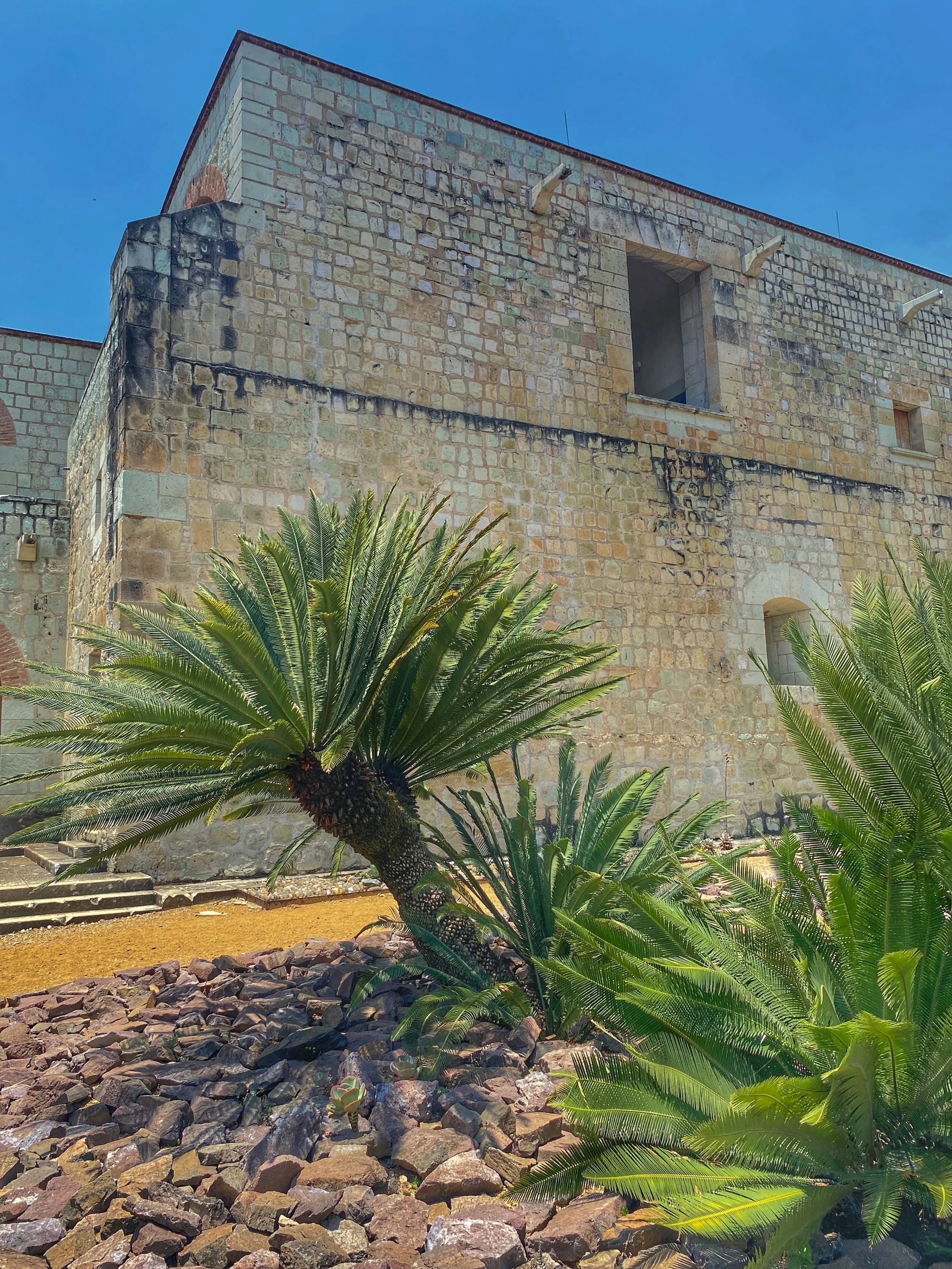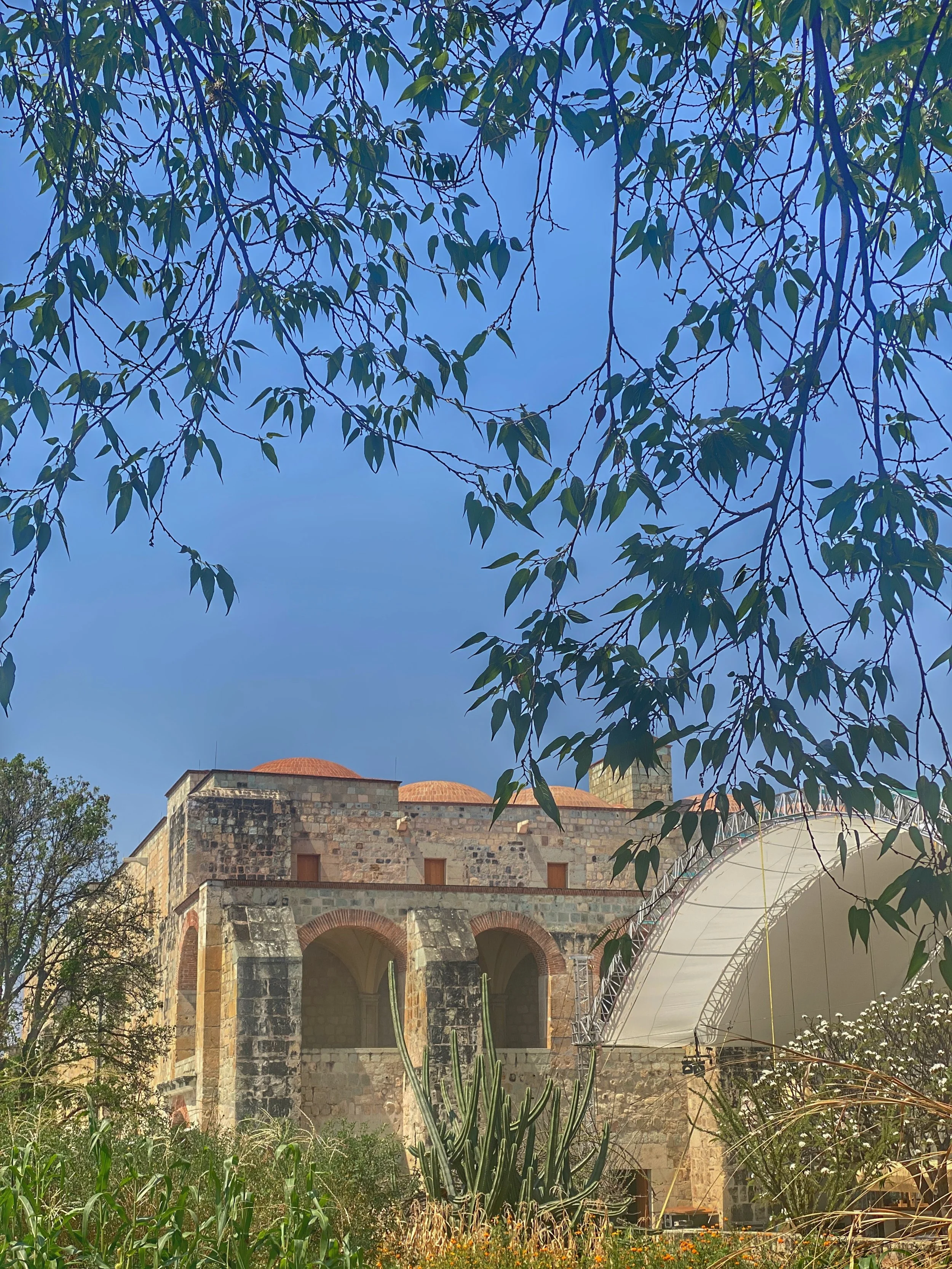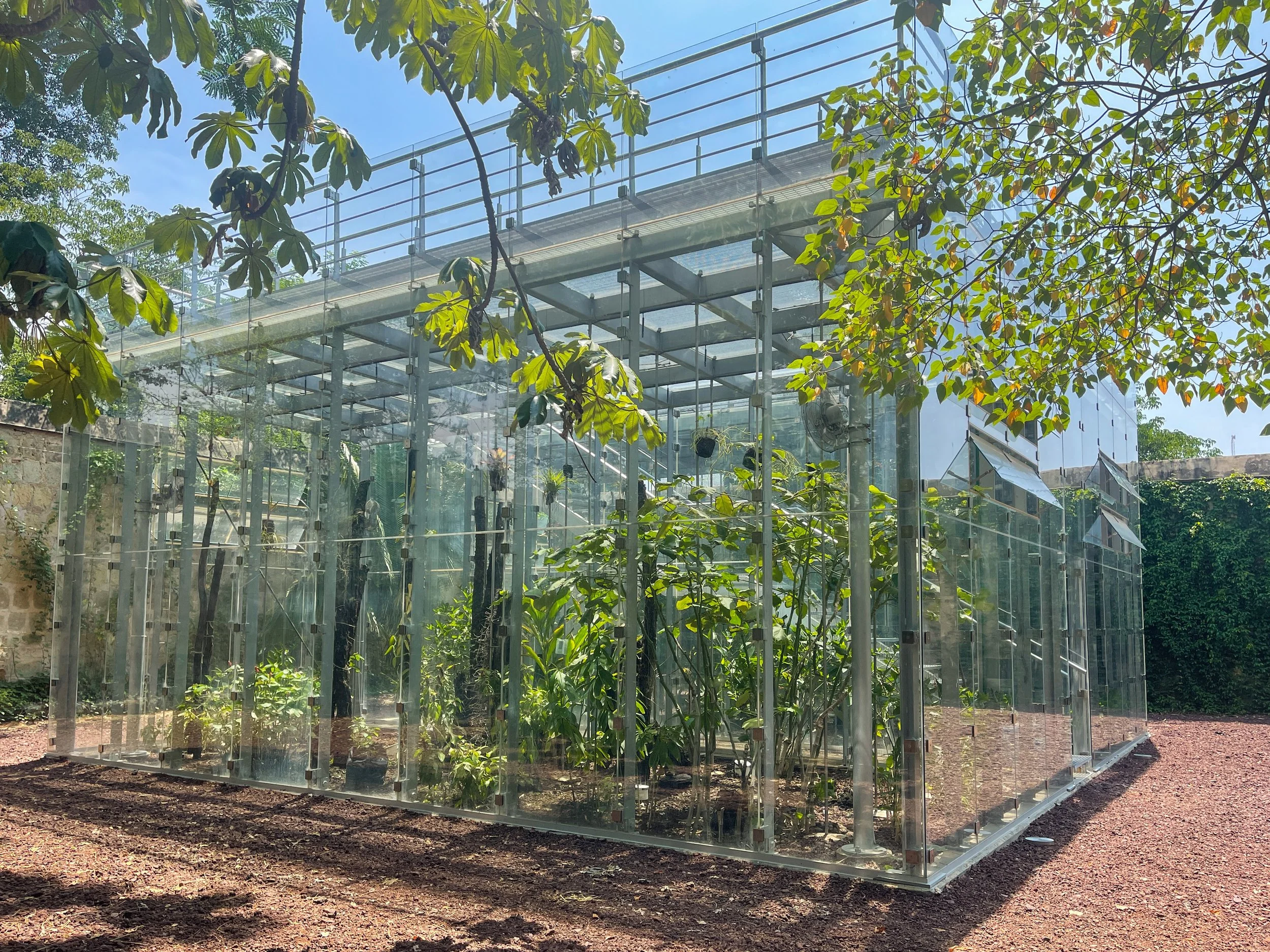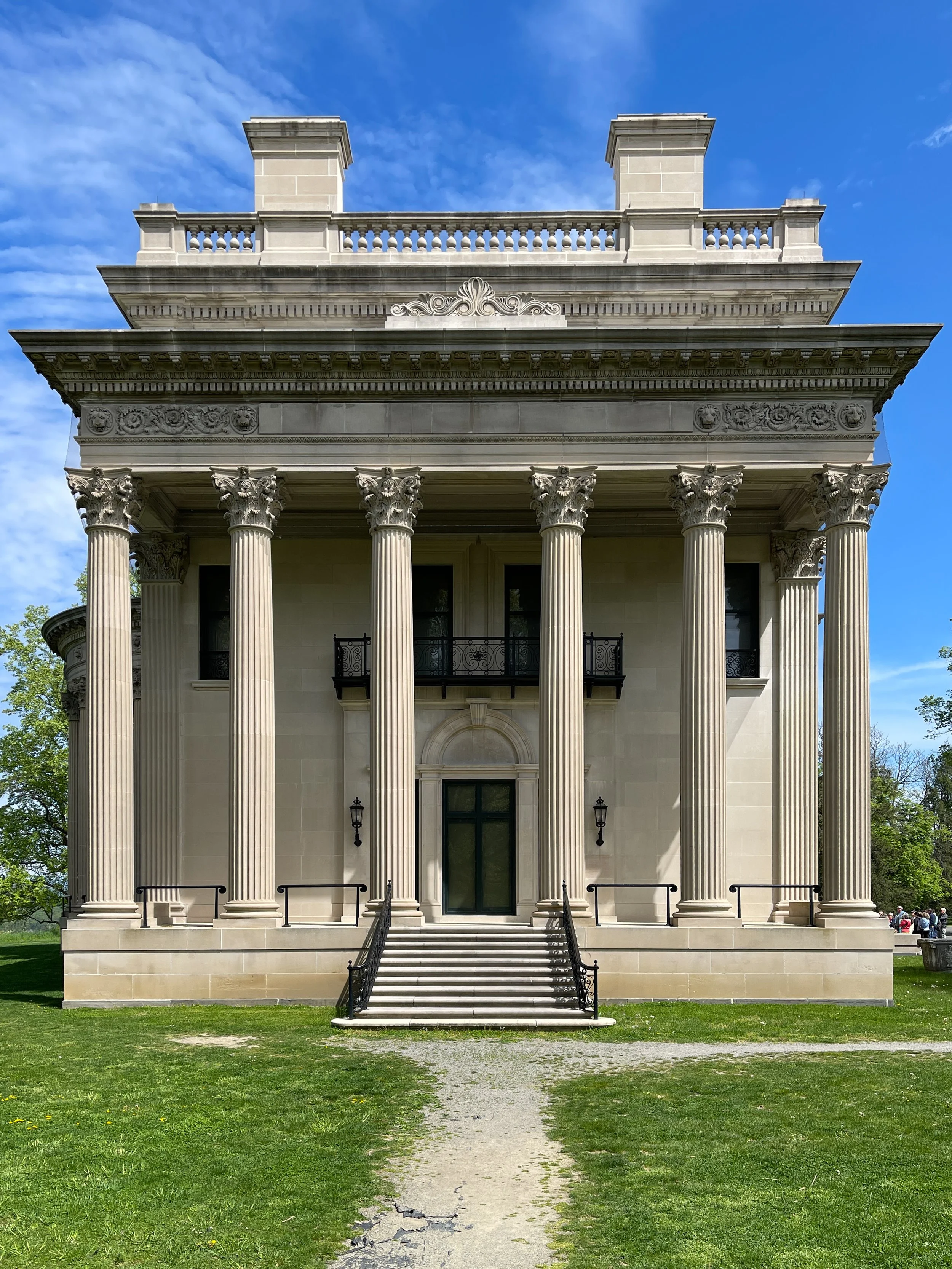El Jardín Etnobotánico de Oaxaca began as a monastery, then was taken over by the military. Now it’s a fascinating and gorgeous reflection of the diversity of plant life found in Oaxaca.
The Oaxaca Botanical Garden offers one tour in English a day — so be sure to get there early to make sure you get a spot!
I’m obsessed with Carol. She was our guide at the Jardín Etnobotánico de Oaxaca. She makes even the most mundane things seem fascinating. Mind you, she’s strict — you’ve gotta follow the rules or risk a scolding — but she also has a great sense of humor.
Our tour guide, Carol, was a wealth of knowledge — and humor.
I’ve transcribed Carol’s tour. Reading her words should give you a good feel for her extensive knowledge (and sense of humor). Hopefully it’ll transport you to the garden — the next best thing to taking an actual tour:
Looking around, I’m guessing most or all of you are visitors. I certainly know that the country’s cultural richness is usually a major reason for people to visit. But you may be less aware of Mexico’s botanical richness. Mexico, in fact, has some of the richest flora in the whole world.
Mexico is also renowned for the great number of plant types to grow uniquely here. Botanists call these endemic — plants that grow only in a limited area. And Oaxaca state has more species of plants, and more endemic species of plants, than in any other part of the country. In fact, all the different kinds of vegetation that grow throughout Mexico can be found right here.
The Oaxaca Botanical Garden has only been open since 1994 and covers an area of about six acres.
But very clearly interconnected with this rich flora, Oaxaca state is also known for ethnic diversity. The state has more indigenous groups than any other part of Mexico. Given the size, the state of Oaxaca is more linguistically diverse than any other part of the Americas, and one of the most linguistically diverse in the world.
Each of the peoples here had their own names, uses, beliefs and traditions about the plants.
The back of Santo Domingo de Guzmán church, which once owned the land upon which the botanical garden now sits.
Dominican Monastery to Military Grounds: the Complicated History of the Jardín Etnobotánico de Oaxaca
The garden was founded in 1994. Because of the dual emphasis on the relationship of the people and plants, the formal name is the Ethnibotanical Garden.
The garden covers an area of just over two hectares, or approximately six acres.
This was originally part of the Dominican monastery, and the Dominican friars began building Santo Domingo in the 1570s. They moved into the monastery in 1608 and remained there till the 1860s.
The Dominicans used the space firstly as a construction zone, which is where they prepared all the materials to build and later maintain Santo Domingo. We know they used it subsequently for washing and bathing. There’s evidence they pastured some animals out here. We know they did pottery and metalwork in this space. We have no evidence of any food crops in the space which today serves as the garden.
The botanical garden was once where monks bathed, and later, where cavalry soldiers performed drills.
The Dominicans were expelled in the early 1860s — at a time when, nationwide, all church properties were expropriated and nationalized. The federal government took over the whole complex and handed the entire thing to the military, and Santo Domingo served as a cavalry base until 1993.
The military used this space to exercise forces, to hold military practices, to park military vehicles. They had sports fields out here and so on. They destroyed the Dominicans structures out in the field area that were tall — anything that stuck up got lopped off.
But a number of low structures built by the Dominicans, covered over and buried during that military period, have survived till today.
The military use, however, destroyed all the vegetation from the Dominican period. We don’t have one single plant here that has survived from then.
No longer a part of Santo Domingo church, the botanical garden showcases plants from the state of Oaxaca.
The Opening of the Oaxaca Botanical Garden
The military left, as I said in 1993, and the garden was formally organized in 1994. They started to reconstruct the buildings, so from ’94 to ’98, nothing much happened vis-à-vis the garden.
It was finally in 1998 that they began to prepare the soil, to plan out the garden and to begin planting, and the garden opened to the public in late 1999.
So it’s a very young garden, with lots of plants here that couldn’t possibly have grown here in this time period. Anything very tall, big, old has been transplanted.
A cistern under the wedding venue holds over 1 million liters of rainwater, which is used to irrigate the massive garden.
When the garden was founded, the goal was not just to make an attractive botanical garden — though they certainly wanted to do that — but to make it a Oaxacan garden.
And they have done that in several ways. One, of course, is with the collection of plants. All the plants come only from Oaxaca state. So many of these plants may grow elsewhere as well, but they are collected only from the Oaxacan community.
Another way was in the design of the garden. The garden was designed not by landscape architects but local artists, who took as their theme a pre-Hispanic design element that’s very typical of Oaxaca. And you’ll see it most clearly at the archeological site of Mitla. Those zigzags — some are mosaic, some are actually carved in stone, but they’re zigzag designs that are referred to as grecas.
Note the zigzagging pathway — it’s a recurring motif at the botanical garden.
And that’s the thing that you see throughout the garden. Notice the beds aren’t square or rectangle. Nothing is curved. As you go through the garden, with the water channels and pathways, everything zigzags.
All of the money raised from the lavish weddings at the Oaxaca Botanical Garden go to the state.
The Question of Funding
When the garden was founded, it was a public-private partnership, two public, two private partners. It was wonderful. It lasted until the end of 2005. And at the beginning of 2006, that public-private partnership — called a fideicomiso here — dissolved. And we were, for five seconds, hopeful that we would become entirely an NGO [non-governmental organization].
But, in fact, the state took it over. So since 2006, we have been a state agency. We have no juridical independence; we don’t exist as a legal entity apart from the state. So, unfortunately, folks, you can’t donate money to us. Because everything goes through the state.
So that’s where we are. It’s totally top-down, and all the money from those weddings here goes to the state. The donations? That now goes to the state as well.
Solar power and geothermal cooling make this greenhouse an actual green building.
A Truly Green Greenhouse
As we start up into the garden, we will be passing a number of those Dominicans structures that I mentioned. Those relate us to our past. Down in the corner is the future. We always wanted a real greenhouse and we finally got one in 2007.
It consists of two rooms: a colder room and a warmer, more humid room to show plants that will not grow well in this climate.
Greenhouses, by their very name, should be green. But most of them are not — only the plants are green. But this one is truly green. It is totally self-sustaining. All the power to run it comes from solar panels on the roof of the buildings where you enter the garden.
All the electrical lighting is solar-powered. The heating and the cooling? Also solar power. The cooling is geothermal cooling. And the water is all rainwater to irrigate. In fact, the entire garden is irrigated with rainwater. Santo Domingo has several acres of rooftop. And the rainwater is fed from the rooftops by waterspouts onto the terraces and runs into this giant underground cistern, where they’re putting up that structure for another fancy wedding this weekend.
Under the floor is the cistern. It was built in 1998 to store over 1 million liters of rainwater. It is the largest rainwater cistern in the entire state of Oaxaca. And then that water can be pumped to wherever it’s needed. There are outlets periodically where you attach a hose. All the irrigation is manual, but it’s all rainwater-fed.
You can’t go in the greenhouse, alas, but you can admire its design.
The greenhouse was designed by a Mexican architect [Francisco Gonzalez-Pulido] who received an architectural award in 2018 for best sustainable building. The greenhouse is not open to the public — you’ll have to stand outside and look. But it really represents our future, and I hope everyone’s.
End your tour with the money shot, as Duke and Wally did. (And consider accepting one of the hats they offer to protect you from the sun.)
Before You Go
Even if you don’t consider yourself overly interested in plants, we recommend touring the Oaxaca Botanical Garden. You can’t wander through on your own, but they give tours in English once a day, at 11 a.m. Monday through Saturday. They only let 25 people join each tour, so play it safe and get there at least 45 minutes beforehand to get on the list. The entrance is at the corner of Reforma and Constitución. Tours cost 100 pesos (a bargain at about $5), and kids 12 and under get in free. Wear sunscreen — some of the time will be spent in the sun. The walk lasts about two hours — but, if you’re lucky enough to get a fantastic guide like Carol, the time will fly by. –Wally
The Oaxaca Botanical Garden should be towards the top of your to-do list when visiting this area.
Jardín Etnobotánico de Oaxaca
Reforma Sur Norte
Ruta Independencia
Centro
68000 Oaxaca de Juárez
Oaxaca
Mexico










































